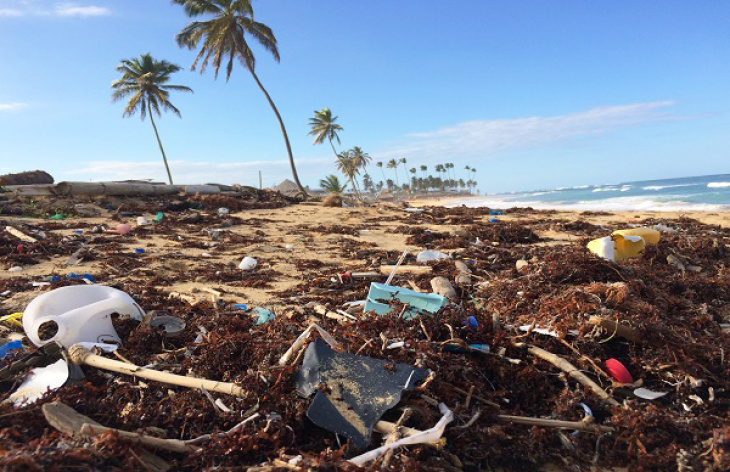Plastic Web Quiz and more
In the Kenyan capital of Nairobi, from November 13 to 19, 2023, the negotiations on the envisaged global plastics agreement will enter a new round. Under the umbrella of the United Nations, all relevant issues will be discussed and wrestled over. In this context, researchers at the Helmholtz-Zentrum Hereon, together with international partners, are providing supplementary scientific fact checks and background information - including a new quiz that takes a playful approach to the topic. The processed knowledge is bundled in Hereon’s online application Coastal Pollution Toolbox of the Hereon.
This is the third round of negotiations in which the planned plastics agreement is to be taken forward. After the first two meetings of the Intergovernmental Negotiating Committee (INC) in Uruguay and France revolved around the framework conditions of the agreement, the so-called 'Zero Draft' is now available - a first paper with possible measures against plastic pollution and risks over the entire product cycle. From production to use to disposal. At INC-3 in Kenya, this draft is to be discussed and further elaborated.
The Helmholtz-Zentrum Hereon, in cooperation with the University of Strathclyde in Glasgow and the communications agency Ahnen&Enkel, provides detailed fact checks and background information. The following tools and articles are now available on the Coastal Pollution Toolbox (CPT) - recently declared a UN Ocean Decade project - on the Internet in English.
Plastic Mythbusters

Plastic in the ocean and the rest of the environment: the problem of littering urges action. Photo: Dustan Woodhouse via unsplash
The Plastic Mythbusters web quiz opens up a playful approach: visitors can use the tool to test their knowledge of plastics. Which statements that circulate virally in the media and in public discourse are really true? Which are uncertain or lack any scientific basis? The quiz is based on a crowd-sourced collection of facts and myths that plastic experts compiled on own initiative via social media four years ago. For example, is it a fact or a myth that we all consume plastic in the amount of a credit card every week? Experts conclude that this claim is not true and misrepresents the state of scientific research. They say the fact that some amount of microplastic enters the body is indisputable, but the amount is unclear. Other studies assume that humans consume less than the equivalent of one grain of salt per week.
The Hereon Institute of Coastal Environmental Chemistry team and partners at the University of Strathclyde have now selected the most prominent plastic myths and reviewed and updated them with detailed fact checks. Each fact check is available in a short and a detailed version that provides further information. The detailed check has been peer-reviewed by recognized researchers working internationally on the topic of plastics in the environment. In addition to myths, the quiz also embeds validated scientific findings around the topic.
“Gamification is a great way to communicate scientific issues and we hope that anyone with an interest in plastics will find this resource useful and thought provoking,” says Prof Lesley Henderson from the University of Strathhclyde. "Of course, it's not about downplaying the problem of plastic in the world's oceans. On the contrary, dispelling myths is an important step towards getting to the facts. Science works, essentially, by assessing uncertainties and communicating them clearly. Society has a right to this," says Hereon Institute Director Prof Ralf Ebinghaus. Dr Melanie Bergmann from the Alfred Wegener Institute, Helmholtz Centre for Polar and Marine Research (AWI), an internationally renowned expert in this field, makes it clear that this has practical consequences for decision-makers: "If you believe, for example, that there is a garbage patch the size of France and Germany in the North Pacific, you are probably in favour of ocean cleanups. However, if you know that the plastic there is spread over huge areas and results in a kind of very thin plastic soup, this approach seems less sensible, especially if more and more plastic is being added at the same time because production is not being curbed."
Background-article
The background article The Path to a Global Plastics Treaty describes the process, the history and the topics of the negotiations on the joint agreement. A timeline is used to trace the ambitious agenda of the United Nations, which is expected to produce an agreement as early as mid-2025. Statements from researchers in the global scientific community on plastic pollution and the circular economy explain what needs to be considered from a scientific perspective - so that the environmental, health and societal problems of plastics are truly solved.
Microplastic Compendium
For those who want to delve deeper, the Microplastic Compendium explains in detail the scientific background to the topic of microplastics. In the web compendium, users will find well-founded information and many descriptive graphics on the extent of the pollution, the possible consequences and also politically feasible solutions.
"For a successful plastics agreement, it is centrally important that the discussion and decisions take place on a scientific basis," says project coordinator Ralf Ebinghaus. "On the Coastal Pollution Toolbox, we want to use playful, informative and background formats on the Internet to provide all interested parties with a well-founded, but also entertaining introduction."
Further Information
Contact
Head of the institute
Phone: +49 (0) 4152 87-2354
Institute of Coastal Environmental Chemistry
Helmholtz-Zentrum Hereon
Press Officer
Phone: +49 (0)4152 87-1648
Communication and Media
Helmholtz-Zentrum Hereon
